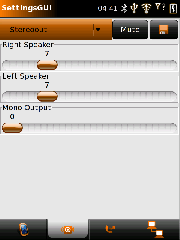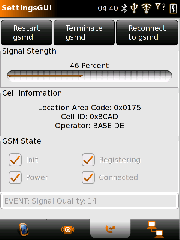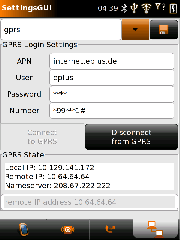SettingsGUI
From Openmoko
(→Environment: mention source package names too) |
(→Environment: more source packages) |
||
| Line 74: | Line 74: | ||
== Environment == | == Environment == | ||
| − | The following archives will have to be installed (source packages python | + | The following archives will have to be installed (source packages: python python-pygtk python-pycairo python-pygobject): |
* python-core | * python-core | ||
Revision as of 02:47, 12 September 2007
| In progress: This article or section documents one or more features whose implementation are in progress. |
Contents |
Overview
Until OpenMoko releases an official GUI-Tool to change settings, SettingsGUI allows you to set various settings of the gta01.
This programm is written in Python using pygtk. It can be used only if those are present in your environment.
(see SettingsGUI#Environment)
Current Features
- Screen (Backlight enable/disable, Backlight brightness, Screen Orientation)
- Audio (profile selection, volume, mute, save to profile)
- GSM (restart gsmd, signal strength, provider, status)
- GPRS (load and save settings from and to /etc/ppp/peers/, connect, set APN, User, Password, Number)
Planned Features
- GSM (Provider selection)
- Bluetooth (device scanning, connection, signal strength)
- GPRS (display transfer rate)
- Battery (show capacity, voltage, charger-status)
Comment on GSM Support
- As there are no gsmd python bindings available at the time, SettingGUI uses python-subprocess and threads to communicate to the commandline of libgsmd-tool for the time being.
Comment on GPRS Support
This is still experimental.
If you have problems connecting check:
- If the modem is initialized and registered to a network ("Reconnect to gsmd")
- If your login data (mostly APN and User are okay)
- For the current (2007-09-06) version of gsmd it sometimes helps to kill the gsmd (to prevent interference)
- There is a button to do so in the gsm settings ("Terminate gsmd")
- Keep in mind that you can't check the connection state after that
- The gsmd start up script currently could freeze the device ("Restart gsmd")
The connection will be terminated when you quit the application.
However saved peer configurations can be called independently using:
pppd debug call gprs # where gprs is the peer
Default configuration files are defined in GlobalConfiguration.py. The peer configuration, a connect- and disconnect chat script are written to /etc/ppp/peers/ on first startup if you don't already have a peer in /etc/ppp/peers/. When the connect button is pressed SettingsGUI will create latest_* files in /etc/ppp/peers/ and start the pppd with this latest_* peer.
SettingsGUI also brings a default Nameserver in case you don't have a valid /etc/resolve.conf. The IP is from the OpenDNS Project and will only work if your GPRS provider allows DNS access to this server.
If you have to change anything else than APN, user, password or dial in number for your provider please leave a note at the Discussion Page.
For details and background information on GPRS see Manually using GPRS.
Download
SettingsGUI-0.6.tar.gz (Mirror)
Thanks to Alessandro there also is an .ipk and a .bb file. Have a look at his user site.
Environment
The following archives will have to be installed (source packages: python python-pygtk python-pycairo python-pygobject):
- python-core
- python-misc
- python-lang
- python-pygtk
- python-subprocess
- python-threading (should be a dependency of python-subprocess - todo: fix)
- python-pygobject (should be a dependency of python-pygtk - todo: fix)
If you want to test this and do not have a build environment, you can 'ipkg install' the python components from the ScaredyCat repositories.
| NOTE: These packages take up a considerable amout of space (about 10 MByte), make sure that you have enough free space or install the packages to the media card as explained in package management. |
Installation / Execution
- download file to Neo (e.g. using wget)
- Uncompress tar.gz file (e.g. e.g. tar -xzvf file.tar.gz)
- run:
export DISPLAY=:0.0 python SettingsGUI-x.x/SettingsGUI.py &



